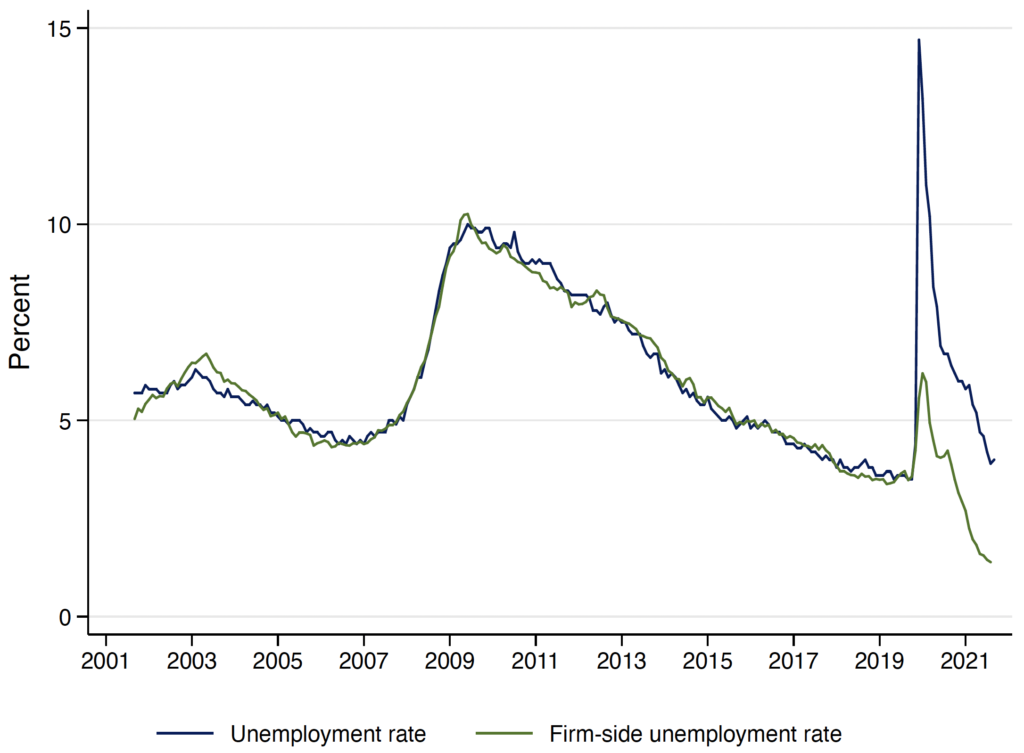Saturday, May 7, 2022
The US labor market could be cooling down now
Source: Peterson Institute of International Economics
While a lot of research conducted from 2021 until March of 2022 suggests that labor markets in the US reached record high levels of tightness as job openings and quits rose, recent evidence collected by the Peterson Institute indicates the possibility of a potential cool down. The underlying argument driving this idea is that the sharp spike in nominal wages in 2021 could have been a result of some post-pandemic factors that shaped expectations of longer-run inflation which ultimately got dragged until 2022. So even though labor force participation rates in the US in April 2022 remained at 3.6%, 0.1% higher than the corresponding pre-pandemic level, the authors argue that this shortfall in employment is driven by a labor supply shortage as demand is robust.
The article also touches upon related issues like rising nominal wages that are beginning to plateau now and a somewhat alarming drop in real wages.
Read the full article to know more.
Source: Peterson Institute of International Economics
While a lot of research conducted from 2021 until March of 2022 suggests that labor markets in the US reached record high levels of tightness as job openings and quits rose, recent evidence collected by the Peterson Institute indicates the possibility of a potential cool down. The underlying argument driving this idea is that the sharp spike in nominal wages in 2021 could have been a result of some post-pandemic factors that shaped expectations of longer-run inflation which ultimately got dragged until 2022.
Posted by at 10:49 AM
Labels: Inclusive Growth
Sunday, March 20, 2022
An assessment of US labor market rigidity
Source: VoxEU CEPR
Abstract: Since the beginning of the pandemic, labour market indicators have been sending different signals about the degree of slack in the US labour market. This column uses time-series and cross-section data to show that firm-side unemployment (figure underneath) – a measure that ties together the unemployment rate with the vacancy and quits rate – predicts wage inflation better than the unemployment rate or the employment ratio, and that firm-side unemployment currently experienced in the US corresponds to a degree of tightness previously associated with sub 2% unemployment. The findings suggest that labour markets in the US are extremely tight and will likely contribute to inflationary pressures for some time to come.
Figure: Actual unemployment rate versus firm-side estimated unemployment rate

Source: VoxEU CEPR
Abstract: Since the beginning of the pandemic, labour market indicators have been sending different signals about the degree of slack in the US labour market. This column uses time-series and cross-section data to show that firm-side unemployment (figure underneath) – a measure that ties together the unemployment rate with the vacancy and quits rate – predicts wage inflation better than the unemployment rate or the employment ratio,
Posted by at 10:58 AM
Labels: Inclusive Growth
Wednesday, February 2, 2022
Slowing Women’s Labor Force Participation: The Role of Income Inequality
Source: NBER Working Paper
Historically, the number and wages of women in the labor force grew at a significant pace during the 1970s and 1980s but began stalling in the early 1990s, especially for college graduates.
In this paper, the authors have argued that this discontinued growth since the 1990s is a consequence of growing inequality. They show that slowdown in participation and wage growth was concentrated among women married to highly educated and high-income husbands, whose earnings grew dramatically over the period under study. Through a model of household labor supply, they qualitatively analyze the above-mentioned effect and account for the rise in the gender wage gap for college graduates.
Source: NBER Working Paper
Historically, the number and wages of women in the labor force grew at a significant pace during the 1970s and 1980s but began stalling in the early 1990s, especially for college graduates.
In this paper, the authors have argued that this discontinued growth since the 1990s is a consequence of growing inequality. They show that slowdown in participation and wage growth was concentrated among women married to highly educated and high-income husbands,
Posted by at 7:39 AM
Labels: Inclusive Growth
Friday, December 10, 2021
A Better Deal for the World’s Workers
In a recent column (2021) for Project Syndicate, Professor Dani Rodrik (Harvard Kennedy School of Government) writes that strengthening workers’ bargaining power and increasing the supply of good jobs for those who most need them is the way for boosting workers’ incomes and ensuring a fairer share of the prosperity pie for them.
“In advanced economies, earnings for those with less education often stagnated despite gains in overall labor productivity. In developing countries, where standard economic theory predicted that workers would be the main beneficiary of the expanding global division of labor, corporations, and capital again reaped the biggest gains.”
The article then moves on to discuss strategies that can counteract this problem such as firms’ investment in the happiness and productivity of their workers, increasing organizational power of workers, expansionary macroeconomic policies that can generate derived demand for labor, etc.
Click here to read the full article.
In a recent column (2021) for Project Syndicate, Professor Dani Rodrik (Harvard Kennedy School of Government) writes that strengthening workers’ bargaining power and increasing the supply of good jobs for those who most need them is the way for boosting workers’ incomes and ensuring a fairer share of the prosperity pie for them.
“In advanced economies, earnings for those with less education often stagnated despite gains in overall labor productivity. In developing countries,
Posted by at 2:17 PM
Labels: Inclusive Growth
Subscribe to: Posts



